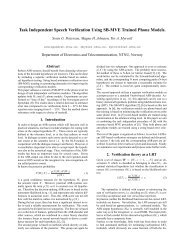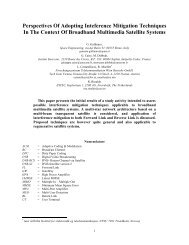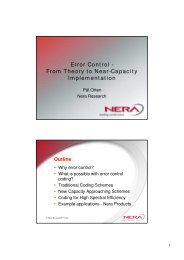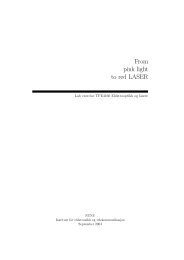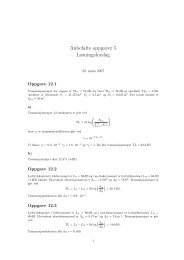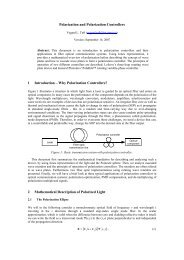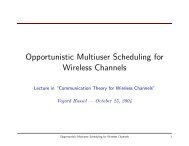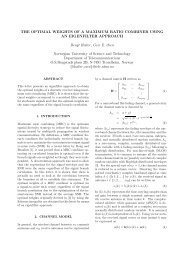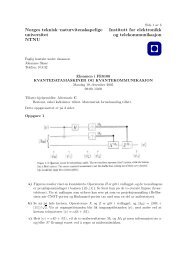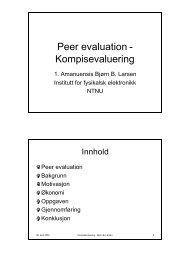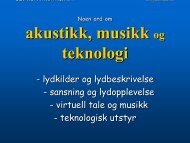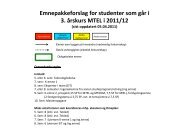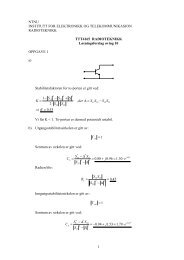LDPC CODED ADAPTIVE MULTILEVEL MODULATION ... - NTNU
LDPC CODED ADAPTIVE MULTILEVEL MODULATION ... - NTNU
LDPC CODED ADAPTIVE MULTILEVEL MODULATION ... - NTNU
Create successful ePaper yourself
Turn your PDF publications into a flip-book with our unique Google optimized e-Paper software.
where a k is the fading amplitude, x k is the transmitted<br />
channel symbol (in general complex), and z k is<br />
complex AWGN. The fading amplitude is also in general<br />
complex, but may be assumed to be real-valued<br />
if perfect coherent detection is assumed at the receiver<br />
end. We shall adopt this commonly used assumption<br />
throughout this paper.<br />
The fading amplitude a (for notational simplicity<br />
we suppress the time dependence from now on) can be<br />
described as a stochastic variable, whose distribution<br />
we assume to be known. One particularly interesting<br />
distribution is the Nakagami distribution [9]:<br />
p A (a) = 2 ( m<br />
) m<br />
a 2m−1<br />
Γ(m) 2σ 2 e −ma2 /2σ 2 (2)<br />
Here, m> 1 2<br />
is the Nakagami parameter, σ2 is the<br />
fading amplitude variance, and Γ(x) is the gamma<br />
function defined by<br />
Γ(x) =<br />
∫ ∞<br />
0<br />
y x−1 e −y dy, x > 0. (3)<br />
The Nakagami distribution is of such interest because<br />
it allows for modelling of a wide range of fading environments<br />
by varying m, while yielding closed-form expressions<br />
for many interesting features of the channel,<br />
such as channel capacity. For m = 1 the model corresponds<br />
to the Rayleigh fading model which is common<br />
in mobile communications when there is no line-ofsight<br />
(LOS) path between transmitter and receiver.<br />
Increasing m will model less severe fading environments.<br />
If a is Nakagami distributed, the CSNR will be<br />
Gamma distributed as shown in Equation (4), γ and<br />
γ being the instantaneous and expected CSNR respectively<br />
[4].<br />
( ) m m γ m−1<br />
p γ (γ) =<br />
(−m<br />
γ Γ(m) exp γ )<br />
, γ ≥ 0 (4)<br />
γ<br />
Under the assumption of perfect knowledge of the<br />
channel state information (CSI) both on the receiver<br />
and transmitter side, the maximum average spectral<br />
efficiency (MASE), or channel capacity, of a Nakagami<br />
multipath fading (NMF) channel has been shown<br />
to be given by [1, Eq. 23]<br />
m−1<br />
∑<br />
MASE = log 2 (e)e m/γ<br />
k=0<br />
( m<br />
γ<br />
) k (<br />
Γ −k, m )<br />
γ<br />
(5)<br />
where Γ(x, y) is the socalled complementary incomplete<br />
Gamma function, which is commonly available<br />
in numerical software such as MATLAB or Maple.<br />
The MASE provides an ultimate performance benchmark<br />
for the spectral efficiency of any practical communication<br />
system communicating over this channel.<br />
It has been shown that in order to efficiently exploit<br />
the channel’s capacity over time without excessive<br />
delay, a transmitter should switch between different<br />
codes of different spectral efficiencies—in other words<br />
adapt itself to the changes in channel quality as done<br />
by adaptive coded modulation.<br />
3. ACHIEVING CAPACITY ON AWGN<br />
CHANNELS: <strong>LDPC</strong> CODES<br />
In [10, 13] it is shown that carefully designed Low-<br />
Density Parity Check (<strong>LDPC</strong>) codes almost attain<br />
the Shannon channel capacity, i.e. the ultimate performance<br />
limit, for AWGN channels with BPSK modulation.<br />
The reason for this record-breaking performance<br />
of <strong>LDPC</strong> codes can at least partly be explained by the<br />
construction of the codes, to be explained below. According<br />
to Shannon’s Channel Coding Theorem [11]<br />
the channel capacity can be reached by using a code<br />
consisting of very (in principle infinitely) long codewords<br />
picked at random from some suitable distribution,<br />
in combination with a decoder performing an<br />
exhaustive nearest neighbour search.<br />
Since a nearest neighbour search without any constraints<br />
imposed is an NP-complete problem, such decoding<br />
was assumed to be impossible in practice—<br />
before the <strong>LDPC</strong> codes were invented by Gallager [3].<br />
As implied by their name, limiting the space of possible<br />
codes to <strong>LDPC</strong> codes provide an additional property<br />
in the controlled sparseness (i.e., very low density<br />
of non-zero bits in each column) of their parity check<br />
matrices H. This reduces the number of equations to<br />
be solved by the decoder and makes practical decoding<br />
possible by means of iterative methods similar to<br />
those used in turbo decoders.<br />
To be more precise, an <strong>LDPC</strong> code is by definition<br />
a linear error-correcting block code, which is specified<br />
byaverysparseparitycheckmatrixH. A regular<br />
<strong>LDPC</strong> code has an (N − K) × N H matrix with a<br />
constant low number t of 1s in each column, placed at<br />
random. An irregular <strong>LDPC</strong> code has a non-uniform<br />
distribution of 1s in the rows and columns.<br />
In any case, the parity check matrix may be generated<br />
simply by running a binary random generator<br />
(in the regular case, with probability t/N for emitting<br />
1, and probability 1 − t/N for emitting 0). This is in<br />
effect very similar to the code construction used by<br />
Shannon in his proof of the Channel Coding Theorem,<br />
but with the constraint of matrix sparseness added in<br />
order to be able to find viable decoding algorithms.<br />
If the matrix found does not provide a good code, the<br />
random generator is simply run once more. Theoretically,<br />
however, the probability of finding a good code<br />
by such a random construction is very close to 1 if the<br />
code length N is large.



